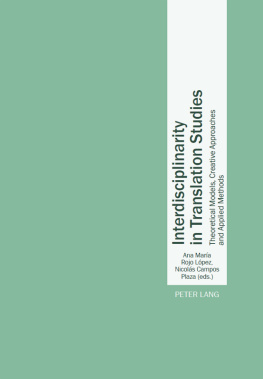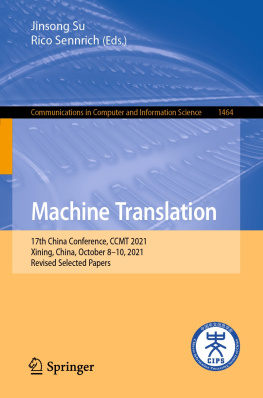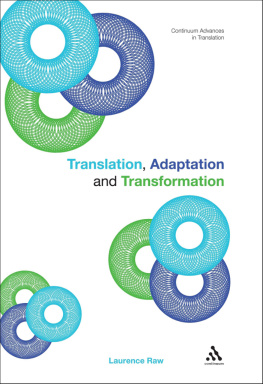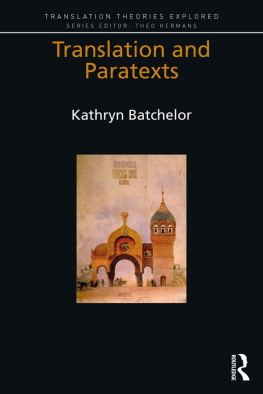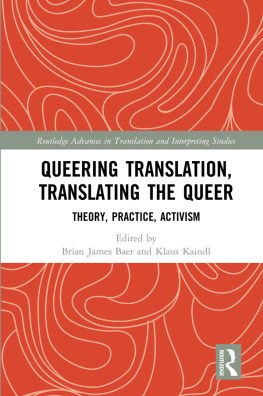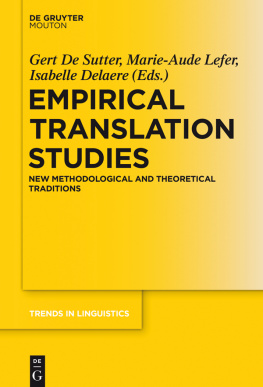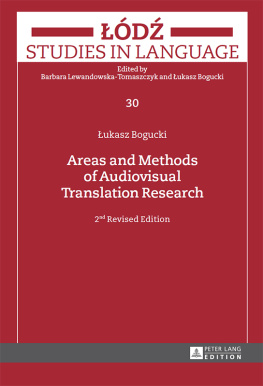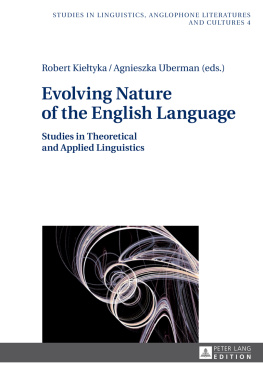Ana Mara Rojo Lpez and
Nicols Campos Plaza (eds.)
Interdisciplinarity in Translation Studies

Theoretical Models,
Creative Approaches and Applied Methods

Bibliographic information published by die Deutsche nationalbibliothek
Die Deutsche Nationalbibliothek lists this publication in the Deutsche Nationalbibliografie; detailed bibliographic data is available on the Internet at http://dnb.d-nb.de.
British Library Cataloguing-in-Publication Data: A catalogue record for this book is available from The British Library, Great Britain
Library of Congress Cataloging-in-Publication Data: 2016943770
ISBN 978-3-0343-2099-3 pb.
ISBN 978-3-0343-2300-0 MOBI | ISBN 978-3-0351-0954-2 eBook
ISBN 978-3-0343-2299-7 EPub |
Peter Lang AG, International Academic Publishers, Bern 2016
Hochfeldstrasse 32, CH-3012 Bern, Switzerland
All rights reserved.
All parts of this publication are protected by copyright.
Any utilisation outside the strict limits of the copyright law, without the permission of the publisher, is forbidden and liable to prosecution.
This applies in particular to reproductions, translations, microfilming, and storage and processing in electronic retrieval systems.
About the Editors
Ana Mara Rojo Lpez is Senior Lecturer in Translation at the University of Murcia (Spain), where she is Coordinator of the Master in Translation for the Publishing Industry. Her current research interests focus on the study of the translation process, with emphasis on the role of emotions, and personality and individual differences. She also works on the area of Cognitive Linguistics applied to translation.
Nicols Campos Plaza is Professor of Translation at the University of Murcia (Spain), where he is Head of the Translation and Interpreting Department. His research interests focus mainly on legal and economic translation, terminology, linguistics and lexicography.
About the Book
The present volume collects a number of works that draw on some of the most relevant disciplines in Translation Studies. All the papers are written in either English or French, and have been grouped into four sections devoted to illustrate the type of interdisciplinary approach adopted in each of the areas of translation under study. The papers draw on different theoretical models and borrow various research methods from neighbouring disciplines. But they all share the common aim of gaining further insight into translation as a text product, a cognitive process, a profession and a teaching field. Works such as the volume presented here contribute to foster collaboration both at an interdisciplinary and international level. The conclusions and implications from these papers may bring us a step closer to understand not only translation and interpreting, but also other communication, cognitive and social processes involved in translating. Their shared enterprise may promote the sort of cooperation and teamwork needed to shape the different interdisciplinary inquiries into a common research agenda of the type needed to have data and results finally converging into a unified theory.
This eBook can be cited
This edition of the eBook can be cited. To enable this we have marked the start and end of a page. In cases where a word straddles a page break, the marker is placed inside the word at exactly the same position as in the physical book. This means that occasionally a word might be bifurcated by this marker.
On the interdisciplinary nature
of translation theory and methodology
9 | 10 10 | 11
Universidad de Murcia (Spain)
On the interdisciplinary nature of translation
Every nation, society and culture communicates through a system of signs that shapes the way we view the world, the way we think, and even the way we feel and live. Language is a unique endowment, essential to our experience as human beings. Understanding its crucial role in constructing knowledge and facilitating communication brings us one step closer to comprehending human nature (Borodistky 2010). The task is complex enough when the focus is on the same linguistic community, and becomes next to impossible when communication across different languages is brought to the fore. The array of languages humans use to communicate with one another is overpowering; but the fact that each language differs from the next in numberless ways is almost insurmountable.
One of the tools humans have developed to bridge over these differences is translation. Translation grows out of the human urge to communicate and provides us with a way to negotiate meaning while threading our way through linguistic and cultural differences. Despite beliefs in cross-linguistic differences in the way we think and notice the world, translation still makes provision for strategies to get at least part of the meaning across. In such a process of negotiation, losses are unavoidable and the ideal of a translation identical to the original is indeed unattainable. Between a source text and its translation, there will always be invisible cracks, unavoidable 11 | 12 fissures that the translator endeavours to cover. But in the same way as readers assume and enjoy the breach between the real world and its fictionated version, we should also understand and accept the gap between an original text and its translation. It is high time we all stop focusing on the fissures and start reflecting on the joints between source and target text. Because those connections are the master key to successful communication; they have opened the door to technological and scientific advances and still keep it wide open to progress.
Even if speakers of different languages pay attention to different things, translators must be skilful enough as to direct their attention to the relevant aspects of meaning so that they have the adequate information to include in their translations. From a translational point of view, the question is not so much whether people think or feel differently when speaking different languages; rather, the crucial question is whether the translation manages or not to transmit the message, employing the necessary strategies to communicate in the target language as much as possible about the events, ideas and feelings rendered in the source language. Even if the speakers of different languages attend to different aspects of the world and use their linguistic resources differently, the meaning they construct is still transferable to another language. A share of the source language worldview may be lost or domesticated in translation or, alternatively, may be rendered to foreignise and enrich the worldview of target language speakers (Venuti 1995). But despite the alien losses or imported gains, the relevant shades of meaning, the essential function of the message, will be communicated in successful translation.
Interdisciplinarity in Translation Studies
Communication sits at the heart of translation. Thus, understanding translation gets us several steps closer to decipher communication processes. Reaching such understanding has been the endeavour of Translation Studies since its origins as an academic discipline. But the problem lies in the extreme complexity of the task. Translation encompasses many different activities, each involving different goals, agents and types of texts. To decipher the mechanisms of such a polyhedral activity, translation scholars have turned to neighbouring disciplines in search of help (Rojo 2015). 12 | 13 Initially they drew upon linguistics and literature, the two disciplines that at the time defined the linguistic nature of the activity and the most frequently translated types of texts.

